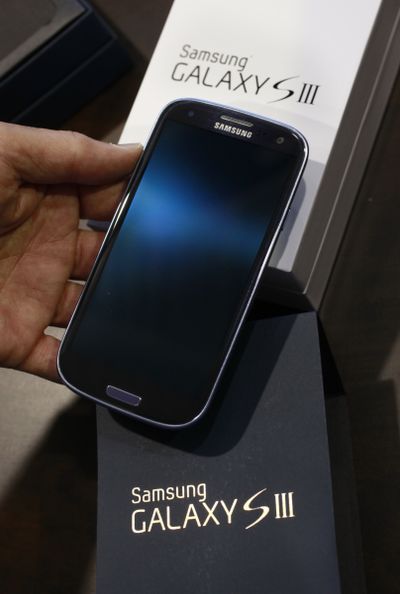Samsung makes its move as iPhone loses appeal

NEW YORK – The once-sexy iPhone is starting to look small and chubby.
That’s become a problem for Apple, which revealed last month that iPhone sales have slowed. Part of the problem is that the competition has found a formula that works: thinner phones with bigger screens.
For a dose of smartphone envy, iPhone owners need to look no further than Samsung Electronics Co., the No. 1 maker of smartphones in the world. Its newest flagship phone, the Galaxy S III, is sleek and wafer-thin. It can run on the fastest networks and act as a “smart wallet,” too – two things the Apple’s iconic phone can’t do.
Says Ramon Llamas, an analyst with research firm IDC: The iPhone “is getting a bit long in the tooth.”
Apple has become the world’s most valuable company on the back of the iPhone, which makes up nearly half of its revenue. The iPhone certainly has room to grow: Only one in six smartphones sold globally in the second quarter had an Apple logo on its back.
When Apple reported financial results for its latest quarter recently, a new phenomenon was revealed: Buyers started pulling back on iPhone purchases just six months after the launch of the latest iPhone model.
Apple executives blamed the tepid sales on “rumors and speculation” that may have caused some consumers to wait for the next iPhone, which is due in the fall. But in the past, iPhone sales have stayed strong nine months after the new model is launched, then dipped as people began holding off, waiting for the new model.
In the April to June period, Apple sold 26 million phones, 28 percent more than it did in the same quarter last year.
Most other phone makers “would kill” for those numbers, says Stephen Baker, an analyst with research firm NPD Group. But since the iPhone’s introduction in 2007, the average annual growth rate has been 112 percent.
The competitor that doesn’t need to kill for those numbers is Samsung, which has solidified its position at the world’s largest maker of smartphones. Analysts believe it sold just over 50 million smartphones in the second quarter, or nearly twice as many as Apple. (The company doesn’t release specific figures.) Its smartphone sales have nearly tripled in a year, from 18.4 million, according to IDC.
Most of Samsung’s sales comprise cheaper smartphones that don’t compete directly with the iPhone. Its flagship phones, though, have emerged as the iPhone’s chief rivals.
Samsung and Apple have a complicated relationship. They’re rivals in the smartphone and tablet-computer markets, and are doing battle in court over mobile patents. Samsung is one of Apple’s largest suppliers of chips and displays, and Apple is one of Samsung’s largest clients.
Together, Samsung and Apple make half of the world’s smartphones, and since competitors are losing money or breaking even, they account for nearly all of the profits in the industry.
Though Apple is known as a relentless innovator, the iPhone’s screen has been the same size – 3.5 inches on the diagonal – since the first iPhone came out. It was a big screen for the time, but among the competition, screen sizes have crept up.
Samsung has increased the screen size of its Galaxy series with every model since it debuted in 2010. The Galaxy S had a screen that measured 4 inches diagonally, and was followed by the S II, at 4.3 inches. The S III, the latest model, measures 4.8 inches. The screen is nearly twice as large as the iPhone’s. Yet the Galaxy is slightly thinner than an iPhone – 8.6 millimeters versus 9.3 – and lighter – 133 grams versus 140 grams.
Samsung has also achieved surprising success with an even bigger phone, the Samsung Galaxy Note. Its 5.3-inch screen makes it somewhat awkward to hold to the ear, but customers don’t seem to mind, or perhaps they value the large screen and included stylus more.
Aside from design, Apple is inflexible in another way: By releasing a new phone only once per year, it lets the competition create new phones with features the iPhone doesn’t have and lets them go unchallenged, at least until the new iPhone comes out.
For instance, the newest Samsung phones can use the latest high-speed data networks in the U.S., and can act as a smart “credit card” at payment terminals in stores, two features the iPhone doesn’t have.
Samsung times its product launches to take maximum advantage of the lull in iPhone sales that usually precedes the launch of a new model. The S III went on sale in Europe in May and in the U.S. in June.
The rest of the competition is in disarray, and hasn’t been able to capitalize in the same way on Apple’s rigid release schedule and conservative design. Nokia Corp., until recently the world’s largest phone maker, is in sharp retreat and is conducting a complete revamp of its smartphones. Research In Motion Ltd. is stuck with outdated software for its BlackBerrys at least until it launches a new operating system next year. HTC Corp. of Taiwan is suffering from marketing missteps in the last few years. LG Electronics, another Korean company, hasn’t been able to keep up with Samsung when it comes to high-end phones, or with cheaper manufacturers on the low end.
Samsung, LG Electronics and HTC Corp. phones all use Google Inc.’s Android operating system, which is seen as the main alternative to Apple’s own software. But Samsung is emerging as the company that’s able to turn Google’s free software into profits.
Analysts now expect the new iPhone to arrive in September or October, probably with a slightly bigger screen.